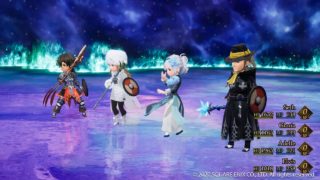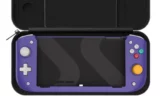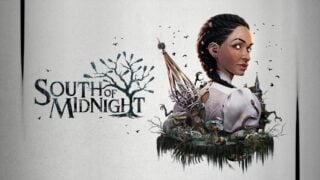Bravely Default 2 review: A tactically smart JRPG that lacks a sense of adventure
The impressive depth of Square Enix’s sequel is bogged down by routine battles and humdrum fantasy
- Director
- Shunsuke Iwami
- Key Credits
- Shota Fukubaru (Designer), Hajime Onuma (Artist)

Does Bravely Default 2 want to save us time or waste our time? It’s hard to say. Square Enix’s sequel goes to great lengths to iron out the minor irritations of traditional 90s JRPGs, only to double down on some major ones.
It’s user-friendly yet stubbornly uncompromising, happy to offer a helping hand one minute then throw you to the wolves the next, like a turn-based good cop bad cop routine. As a modern take on a classic formula, it’s got something to teach the older generation, but seems to have forgotten some crucial lessons itself.
As with the first game, Bravely Default 2 takes its biggest cues from Square’s own Final Fantasy V, with a plot revolving around elemental crystals and anointed heroes, and a similar job system for character development. Again, it’s this smartly flexible means of customising your charges that’s the standout feature, ensuring a widening spread of tactical options as the adventure progresses.
Defeat a boss character and you’ll steal their ‘asterisk’, an artefact that bestows upon its wielder the mystical power to switch careers. Assign one to a team member and they’ll begin to absorb the tricks of a new trade, from the familiar offensive spells of a black mage to the buff inducing entertainment routines of a minstrel or the monster wrangling skills of an animal trainer.
Although a character can only learn one job at a time, they also retain a sub job, allowing them to keep using skills picked up from a previous vocation. Plus they’ll learn passive abilities, such as counter attacks or magic regeneration, which you can switch in or out regardless of their current position. Add to that some tactical weapon and equipment choices and you’ve got a lot of toys to play with.
It’s a shame then that much of the time you’ll be practicing your techniques in tiresomely routine battles.
One change from the first game is that enemy encounters don’t simply trigger at certain intervals as you traverse the map. Instead, monsters visibly stalk the field of play, and give chase when they spot you. Or you can sneak up on them to initiate combat with an advantage.
When you’re touring Bravely Default 2’s open plains and deserts, or diligently grinding towards your next level up or job skill, this all feels very progressive. Deep into the game’s many featureless, mazy dungeons, however, it’s a constant headache. With monsters packed in just a few paces apart, you might exit one battle only to swiftly trigger another, and by the time that’s done you’ve lost your bearings. Yes, there are ways of avoiding confrontations, but you can’t afford to do that often if you want to raise your skill levels sufficiently.
What’s doubly wearying is that many fights are neither trivial enough to feel unobtrusive nor challenging enough to be interesting. Even the titular default system is a burden here, as you wait to store up multiple attacks, or execute an opening barrage that leaves you unable to act for a while after. In minor skirmishes it’s at best irrelevant and at worst slows the whole process down, as foes stick around draining your resources and patience before eventually keeling over.
It’s as if the intricacies of defaulting and job synergies were really built around the game’s lengthy boss battles. Everything in between is the slog of training, interminably waxing on and waxing off to bank skills for these main events. And, yes, the big encounters are genuine tests of ingenuity, coaxing you to carefully manage your turns and often rethink tactics multiple times to match your adversary.
“When you’re touring Bravely Default 2’s open plains and deserts, or diligently grinding towards your next level up or job skill, this all feels very progressive. Deep into the game’s many featureless, mazy dungeons, however, it’s a constant headache.”
Unlike many JRPGs, it’s not merely a question of identifying and targeting vulnerabilities. Attack a boss’s weak point for massive damage and they may well dodge aside or frustrate you with crippling counters. It can feel unfair having your wrist slapped for apparently doing what’s necessary, but it encourages you to be more creative and find another way round.
One of our sweetest victories involved turning our main fighter into a thief focusing purely on stealing the opponent’s BP (bravery points) to stop them unleashing multiple attacks in quick succession. After a string of failures, there’s real reward in finding such a lateral route to success.
But even then, the process of trying, failing, respeccing and retrying is excruciatingly slow. Bosses might cling on for over 15 minutes and then launch a surprise final phase mega attack that sends you back to the drawing board, not even quite sure what went wrong.

There’s a lurching rhythm to Bravely Default 2, then, from cruise control to emergency stop, as if it’s under the influence of its own time spells – slow, haste and stop – cast at random intervals. The sense that it doesn’t know if it wants to be welcoming or intimidating is summed up by a ‘casual’ mode that barely concedes anything – next to useless for those hoping to level off difficulty spikes.
Another dark cloud is that, while it may make sense to revisit the job system from Final Fantasy V, when it comes to plot and characters it’s perhaps preferable to take inspiration from elsewhere. Bravely Default 2’s tale of a princess gathering a band of heroes to restore four lost elemental crystals doesn’t exude much originality, nor epic quality.
Much of the adventure spans just four regions, each with a city that needs saving, a handful of dungeons and various side missions (mostly routine fetch quests or monster slaying chores). The standout episode of the main story is a riff on The Crucible that substitutes fairies for witches, which has some weight and a nice payoff, but is as derivative as it sounds. Equally, the running theme that things aren’t always as black and white as they first appear is far from profound.
“There’s a lurching rhythm to Bravely Default 2, then, from cruise control to emergency stop, as if it’s under the influence of its own time spells – slow, haste and stop – cast at random intervals.”
Bravely Default 2’s world is certainly picturesque, with its watercolour townscapes, underground mines glistening with green lichen, and rolling sands. But it rarely fascinates. Unexpected sights, like a desert city partially submerged in water, are rare and underexploited. Monsters are the usual gaggle of goblins and killer bunnies. Prominent NPCs are kings and usurpers. There’s little subversion of old tropes.
Even your gang is short on spark. Aside from the rather fabulous costumes that come with each new job, there’s no dynamism in their design – dead-eyed puppets with big heads that seem out of place alongside the more realistically proportioned NPCs. And in particular, the two leads, Seth and Princess Gloria, are quite insipid, leaving Elvis the wizard and his mercenary companion Adelle to inject life into the party.
That’s if you don’t get worn down by Elvis’s overwrought Scottish accent. As with the last few Dragon Quest games, Bravely Default 2 differentiates its characters with regional and national dialects, and while that adds flavour, it’s unevenly integrated and tonally haphazard. From one character reeling off olde worlde-isms like lest and thou to another delivering lines like “Smell ya later, drongo,” it’s hard to say what they’re going for.

The counter to many of these criticism of course is that Bravely Default 2 is a love letter to the 90s JRPG. It’s sticking to tradition, staying true to its roots, while adding tactical depth and a range of modern quality of life tweaks. (And these are very welcome, from an instant zoom out feature in towns that highlights points of interest, to on screen quest markers, speed settings for combat and, yes, a Japanese voiceover option.)
But wasn’t part of the appeal of 90s JRPGs that they were cutting edge in terms of visuals, music, storylines and character design? Isn’t that their legacy as much as endless dungeon battles and innovative job systems? It’s not like the old formula hasn’t been revamped and made more captivating before. From Suikoden 2 to Lost Odyssey to Dragon Quest VIII, IX and XI, we’ve seen the template reworked to deliver narratively or underpin epic spectacle.
In such games, dungeon crawling and tough boss battles are mere foundations for exotic worlds or epic sagas, full of intrigue, personality and mystery. In Bravely Default 2, there’s many a moment that raises a smile or kicks your tactical brain into gear, but it lacks that pioneering spirit or a sense of unique identity. While it’s not quite a JRPG by the numbers, it does focus on them a little too much.
The tactical flexibility in Bravely Default 2 is among the best in class, and tinkering with its possibilities is a fine pass-time in itself. But it gets bogged down in a churn of routine battles, wayward balancing and humdrum fantasy. While the original game’s compact focus felt comfy on a 3DS, the Switch magnifies the blemishes of the sequel and leaves it looking a little underdressed.
- Plenty of tactical depth
- Challenging boss encounters
- Some great quality of life features
- Too many battles get in the way of exploring
- Bland story and characters























